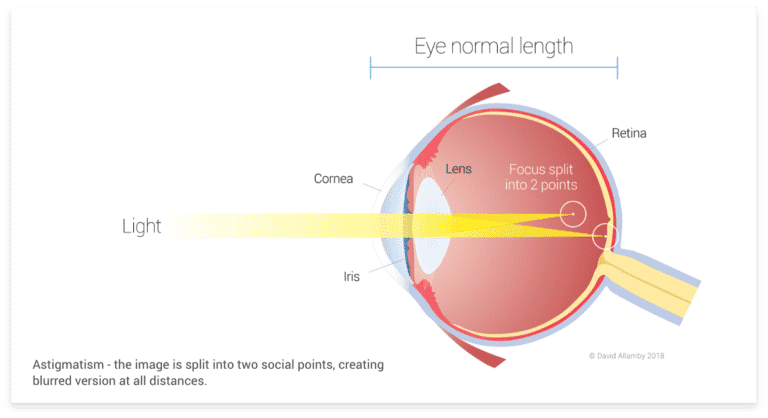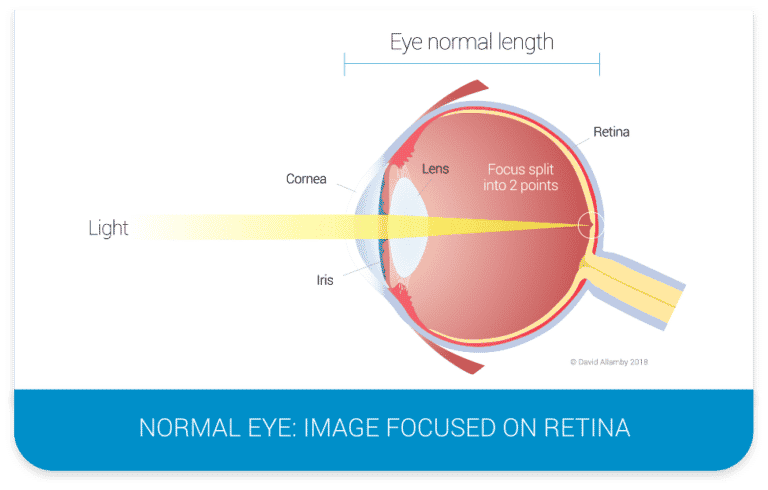Book Your Free Consultation
Mr David Allamby
MD, FRCOphth, FRCS
Prices for treatments in our London clinic start from £4,400 for both eyes.
Book Your FREE
Telephone Consultation
We can give you a good idea of your suitability over the phone and schedule you for an initial consultation.
Prices for laser eye treatments in our London clinic start from £4,800 for both eyes.
Book Your FREE
Telephone Consultation
We can give you a good idea of your suitability over the phone and schedule you for an initial consultation.
Prices for laser eye treatments in our London clinic start from £4,800 for both eyes.
Book Your FREE
Telephone Consultation
We can give you a good idea of your suitability over the phone and schedule you for an initial consultation.
Astigmatism is a common vision condition that can cause distorted or blurry vision. It occurs when the front surface of the eye, the cornea, has an irregular curve. This can cause light rays to bounce off in different directions, making it difficult for your eyes to focus on one object.
If you have astigmatism, you may experience blurred vision at all distances. You may also have trouble seeing objects clearly when they are close up. Astigmatism can be caused by an abnormal shape of the cornea, the clear, front surface of the eye. It can also be caused by an abnormal shape of the lens, the clear part of the eye that helps focus light.
Astigmatism is usually treated with eyeglasses, contact lenses, or refractive surgery. Refractive surgery changes the shape of the cornea to correct astigmatism. The most common type of refractive surgery for astigmatism is LASIK (laser-assisted in situ keratomileuses).
Speak To The Team
We can give you a good idea of your suitability over the phone and schedule you for an initial consultation.
At Focus Clinics, our team has over 70 years of combined industry experience and has completed over 60,000 successful surgeries.
Want to see real reactions from real people, just moments after they've had laser eye surgery?
Speak To The Team
We can give you a good idea of your suitability over the phone and schedule you for an initial consultation.
Correcting astigmatism with LASIK is the treatment of choice and can make a dramatic improvement to the quality of vision
Occasionally astigmatism can be found by itself, but much more commonly together with short-sight (myopia) or long-sight (hyperopia).
When it is combined with these other refractive errors, it will increase the blur and distortion that the patient sees. When someone suffers from significant astigmatism (usually anything more than 0.5 of a dioptre) they will require corrective lenses, usually glasses.
Contact lenses are available for this condition, known as toric lenses, but are not well tolerated by some patients due to the lens rotating on the cornea, blurring vision.
LASIK is the treatment of choice for astigmatism and highly effective. PRK or LASEK is used far less frequently because the technique has significant restriction for this refractive error.
Laser surgery can cure astigmatism once the condition is no longer progressing.
The laser part of the procedure takes 5-10 seconds to evaporate a very thin layer of tissue within the cornea, reshaping its curvature to produce a more spherical cornea.
This eliminates the double focus that is characteristic of astigmatism, allowing all rays of light to come to a single focus.
The whole procedure is complete in approximately 4 minutes per eye.

Speak To The Team
We can give you a good idea of your suitability over the phone and schedule you for an initial consultation.
Most people who have lens replacement surgery will have good distance vision without the need for glasses or contact lenses. However, you may still need to use reading glasses for close work.
Intraocular lens surgery is not usually recommended for people with cataracts who also have a significant amount of astigmatism. This is because the surgeon would need to make a very large incision in the eye to insert the toric IOL, which could increase the risk of complications. In this case, LASIK or PRK would be a better option.

In a normal eye, light enters through the clear cornea, passes through the pupil (the central opening in the iris) and continues through the lens located just behind the iris.
If there is no prescription (refractive error), the cornea and lens focus parallel rays of light to converge together to make a clear image on the retina. This light-sensitive layer converts the light into information that passes along the optic nerve at the back of the eye, taking visual data to the occipital lobe within the rear part of the brain. Neural processes then interpret this information so that you get a visual perception and understanding of the world around you.
Astigmatism is most commonly caused by an asymmetric curvature across the cornea. Imagine the shape of a rugby ball instead of a football. Commonly, horizontal rays of light are focused at one point, and vertical rays at a separate point, rather than all rays arriving at a single focal point.
As a result, light from distant and near objects is not refracted properly and an image will appear blurred or distorted.
A refractive lens exchange can be used to treat high levels of astigmatism. This is where the eye’s natural lens is removed and a new artificial lens (IOL) is placed in its place. This IOL can be a monofocal lens to correct for distance vision or a toric lens which corrects for both distance and astigmatism.
Intraocular lens surgery is a common and safe procedure that has a very high success rate. It is usually performed as day surgery under local anaesthetic and takes around 15 minutes per eye.
Speak To The Team
We can give you a good idea of your suitability over the phone and schedule you for an initial consultation.
Getting my laser eye surgery with Focus was the best decision I ever made. They were so professional and thorough from start to finish. I was clearly informed of all steps from start to finish and on the day of the surgery I was looked after so well, Dr Allamby did an amazing job, it was so quick, easy and painless that I didn't even know it had happened at first!
It's been 3 months since I had my laser eye surgery and I can confirm that the results have been impeccable! The team have always been very professional, attentive and caring. All the aftercare advice provided has really helped my eyes to heal and I can confidently say that they feel more than brand new.
It's been 5 years since i've had laser eye surgery done and it is honestly the best amount of money I have ever spent in my life. I've been suffering for years wearing contact lenses and glasses with constant headaches and dry eyes...For anyone wondering if they should do it, please please please go ahead and do it!
Free retreatment is available if you return to a significant prescription after the initial surgery during the first ten years.
It is common in the first months of life when the cornea's curvature is very steep. As infants grow older, the cornea flattens, and the prevalence of high degrees of astigmatism (>1.00 dioptre) decreases, reaching just 4.8% of preschool children.
The steady reduction of astigmatism to lower values with age is part of normal eye maturation. By the ages of 1-3 years, the vertical and horizontal diameters of the cornea and its elasticity attain adult levels.
Factors that may increase your chance of astigmatism include:
A family history of astigmatism, eye disease, or disorders such as keratoconus (a condition in which the cornea thins and bulges into a cone shape) can increase your risk of developing astigmatism.
Certain types of eye surgery, such as cataract extraction and lens replacement, can sometimes cause astigmatism.
Corneal scarring from injury or disease has been linked to the development of astigmatism.
Corneal scarring can also be caused by refractive surgery, such as LASIK.
Corneal conditions that cause the cornea to become thinner than normal (such as keratoconus) can lead to astigmatism. Most people with these disorders are born with them or develop them during childhood.
Short sightedness and long-sightedness patients may be at greater risk for developing astigmatism, especially when their degree of myopia or hyperopia is high.
Speak To The Team
We can give you a good idea of your suitability over the phone and schedule you for an initial consultation.
Astigmatism is a common refractive error, accounting for as much as 13% of all refractive problems.
Around 63% of young adults aged 20 to 30 years exhibit 0.25 dioptre or more of astigmatism, although only a few have an astigmatism >1 dioptre.
In a research study, only 4.7% of the total population exhibited astigmatism of more than 1.50 dioptre.
Focus has a 100% 20/20 success rate for short-sight including up to 2.00 dioptres of astigmatism, i.e. almost all astigmatic prescriptions
Some ethnic groups show a higher prevalence of astigmatism.
East Asian people show a relatively high prevalence of astigmatism (in addition to myopia), perhaps due to the greater tightness of the Asian eyelids and narrower palpebral apertures.
Most adult astigmatism occurs together with either short-sight or long-sight.
Almost all of these prescriptions can be helped by laser vision treatment, excluding extreme cases.
Speak To The Team
We can give you a good idea of your suitability over the phone and schedule you for an initial consultation.
Laser vision surgery (LASIK) for astigmatism is the treatment of choice in most cases. 97% of Focus patients receive dual-laser advanced LASIK, and 3% undergo PRK.
A-LASIK is an advanced form of LASIK utilising a high numerical aperture femtosecond laser to create the LASIK flap, creating a remarkably accurate focus for precision treatment of astigmatism.
Using the WaveLight laser, which removes less corneal tissue per dioptre than other lasers, we are able to treat most patients up to 6.00 dioptres, which represents almost all astigmatic prescriptions.
Focus have targeted the best reported outcomes for treating astigmatism in the UK – 100% of typical shortsighted patients see 20/20 or better after having LASIK eye surgery at our clinic, including up to 2.00 dioptres of astigmatism (more than 95% of all astigmatism prescriptions, and have done so for the past 3 years.
In fact, the great majority of our patients can see even better than 20/20.
We know of no other clinic that has matched our vision results. Click here to learn more about our surgery outcomes.